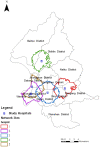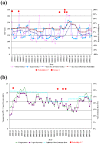Probabilistic daily ILI syndromic surveillance with a spatio-temporal Bayesian hierarchical model
- PMID: 20661275
- PMCID: PMC2905374
- DOI: 10.1371/journal.pone.0011626
Probabilistic daily ILI syndromic surveillance with a spatio-temporal Bayesian hierarchical model
Abstract
Background: For daily syndromic surveillance to be effective, an efficient and sensible algorithm would be expected to detect aberrations in influenza illness, and alert public health workers prior to any impending epidemic. This detection or alert surely contains uncertainty, and thus should be evaluated with a proper probabilistic measure. However, traditional monitoring mechanisms simply provide a binary alert, failing to adequately address this uncertainty.
Methods and findings: Based on the Bayesian posterior probability of influenza-like illness (ILI) visits, the intensity of outbreak can be directly assessed. The numbers of daily emergency room ILI visits at five community hospitals in Taipei City during 2006-2007 were collected and fitted with a Bayesian hierarchical model containing meteorological factors such as temperature and vapor pressure, spatial interaction with conditional autoregressive structure, weekend and holiday effects, seasonality factors, and previous ILI visits. The proposed algorithm recommends an alert for action if the posterior probability is larger than 70%. External data from January to February of 2008 were retained for validation. The decision rule detects successfully the peak in the validation period. When comparing the posterior probability evaluation with the modified Cusum method, results show that the proposed method is able to detect the signals 1-2 days prior to the rise of ILI visits.
Conclusions: This Bayesian hierarchical model not only constitutes a dynamic surveillance system but also constructs a stochastic evaluation of the need to call for alert. The monitoring mechanism provides earlier detection as well as a complementary tool for current surveillance programs.
Conflict of interest statement
Figures




Similar articles
-
Application of change point analysis to daily influenza-like illness emergency department visits.J Am Med Inform Assoc. 2012 Nov-Dec;19(6):1075-81. doi: 10.1136/amiajnl-2011-000793. Epub 2012 Jul 3. J Am Med Inform Assoc. 2012. PMID: 22759619 Free PMC article.
-
Detection of influenza-like illness aberrations by directly monitoring Pearson residuals of fitted negative binomial regression models.BMC Public Health. 2015 Feb 21;15:168. doi: 10.1186/s12889-015-1500-4. BMC Public Health. 2015. PMID: 25886316 Free PMC article.
-
Early detection for cases of enterovirus- and influenza-like illness through a newly established school-based syndromic surveillance system in Taipei, January 2010 ~ August 2011.PLoS One. 2015 Apr 15;10(4):e0122865. doi: 10.1371/journal.pone.0122865. eCollection 2015. PLoS One. 2015. PMID: 25875080 Free PMC article.
-
Comparison of syndromic surveillance and a sentinel provider system in detecting an influenza outbreak--Denver, Colorado, 2003.MMWR Suppl. 2005 Aug 26;54:151-6. MMWR Suppl. 2005. PMID: 16177707
-
Issues in Bayesian prospective surveillance of spatial health data.Spat Spatiotemporal Epidemiol. 2022 Jun;41:100431. doi: 10.1016/j.sste.2021.100431. Epub 2021 May 8. Spat Spatiotemporal Epidemiol. 2022. PMID: 35691635 Review.
Cited by
-
A method for detecting and characterizing outbreaks of infectious disease from clinical reports.J Biomed Inform. 2015 Feb;53:15-26. doi: 10.1016/j.jbi.2014.08.011. Epub 2014 Aug 30. J Biomed Inform. 2015. PMID: 25181466 Free PMC article.
-
Global animal disease surveillance.Spat Spatiotemporal Epidemiol. 2011 Sep;2(3):135-45. doi: 10.1016/j.sste.2011.07.006. Epub 2011 Jul 19. Spat Spatiotemporal Epidemiol. 2011. PMID: 22748173 Free PMC article.
-
Retrospective forecasting of the 2010-2014 Melbourne influenza seasons using multiple surveillance systems.Epidemiol Infect. 2017 Jan;145(1):156-169. doi: 10.1017/S0950268816002053. Epub 2016 Sep 27. Epidemiol Infect. 2017. PMID: 27671159 Free PMC article.
-
Predicting influenza-like illness-related emergency department visits by modelling spatio-temporal syndromic surveillance data.Epidemiol Infect. 2019 Dec 2;147:e312. doi: 10.1017/S0950268819001948. Epidemiol Infect. 2019. PMID: 31787127 Free PMC article.
-
Approaching precision public health by automated syndromic surveillance in communities.PLoS One. 2021 Aug 6;16(8):e0254479. doi: 10.1371/journal.pone.0254479. eCollection 2021. PLoS One. 2021. PMID: 34358241 Free PMC article.
References
-
- Georgantopoulos P, Bergquist EP, Knaup RC, Anthony JR, Bailey TC, et al. Importance of routine public health influenza surveillance: detection of an unusual W-shaped influenza morbidity curve. Am J Epidemiol. 2009;170:1533–1540. - PubMed
-
- Cauchemez S, Valleron AJ, Boelle PY, Flahault A, Ferguson NM. Estimating the impact of school closure on influenza transmission from Sentinel data. Nature. 2008;452:750–754. - PubMed
Publication types
MeSH terms
LinkOut - more resources
Full Text Sources
Medical
Miscellaneous

